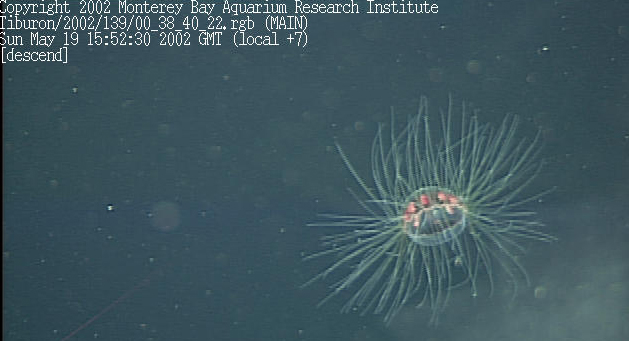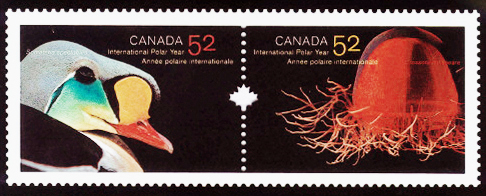C. MILLSAE, NOT QUITE A POSTAGE STAMP

Crossota millsae, deep-sea jellyfish photographed on the Davidson Seamount off California at 3311 meters depth,
May 19, 2002. Credit NOAA/MBARI, image EJB_051902_071.jpg at http://www.sanctuarysimon.org/photos
(photograph in the public domain). Approximately life size - bell diameter is typically 10-20 mm.
Sometimes it is amusing to trace
the origin of news. In this case, my namesake jellyfish was inadvertently honored
(kind of) with a lovely 2007
Canadian stamp (below), published in recognition
of the 2007 International Polar Year.
The story begins in the
late 1980s when some of my colleagues discovered a new and lovely
little jellyfish in very deep water off southern California. More than a
decade later, after bearing for awhile some interesting provisional
names, this jellyfish was officially given my name, Crossota
millsae, in a paper by Erik Thuesen*. Then in 2005, some other scientists found this same little
red and orange deep-sea jellyfish, along with other related species, during a scientific expedition to the arctic.
The Canadians then, with infinite
wisdom, chose to place a jellyfish on one of their pair of stamps
issued February 12, 2007, in honor of the International Polar
Year. This is about the 150th
jellyfish stamp issued by any
country (this
factoid provided by Drs. Makoto Omori and Shin Kubota of Japan, scientists with long careers studying plankton, who are also interested in stamps).

The red jellyfish on the stamp on
the right is labelled in tiny red print on the upper right (and in the news) as Crossota
millsaeare. Here's why - a comedy of errors:
Error number 1: The jellyfish image that was
chosen for the stamp is not the photo taken by Kevin Raskoff of Crossota millsae - the Canadians took the name from Kevin's other
red jellyfish photographed in the Arctic (see both images side-by-side about one-quarter down this web page showing animals of the Arctic from 2002 and 2005 NOAA expeditions) and slipped
it accidently onto the beautiful image of Crossota norvegica that is featured on the stamp.
Error number 2: The name of the jellyfish not pictured on the stamp really is Crossota
millsae (see introductory photo), but someone at the Census
of Marine Life somehow added three extra letters when they
made a press release in 2006, which then moved around the web, and thus Kevin's photo of C. millsae moved all over the web as C. millsaeare. That's why this stamp says Crossota millsaeare, which is a nonsense name and doesn't really exist.
Error number 3: This
isn't really a new discovery from the Arctic as stated in the stamp description, since Crossota millsae was described
in 2003* from deep-sea specimens seen off Southern California and
Hawaii between 1988 and 1996. This species has also been identified from deep-sea photographs
off Japan. The Arctic specimens represent new territory (and
new depths) for this very pretty jellyfish.
Error number 4: Sadly, the Canadian
website describing the stamp does not acknowledge Kevin
Raskoff as the photographer, but a paper by some others instead. Kevin
took this exquisite photo (and also a nice photo of C. millsae)
on a scientific cruise to the Arctic in July 2005. The photograph was taken of a wild-caught jellyfish placed in
a photo-tank on board the ship. Kevin knew the identifications of the jellyfish that he photographed, but the stamp committee looked elsewhere for an opinion, telling Kevin "we'll look into it" when he pointed out the problem, and went ahead and published the wrong name, presumably on someone else's advice.
I am thrilled that a beautiful deep-sea jellyfish bears my name (and that I have seen it in the deep-sea using a remote operated vehicle=ROV). It is too bad, however, that the stamp with a lovely image of Crossota norvegica incorrectly bears the name Crossota millsaeare.
Alas!
There have been quite a few jellyfish postage stamps issued in recent years. Some of these include:
Madagascar issued a jellyfish stamp in 1999 for the International Year of the Ocean.
The United State issued a set of deep-sea organisms on stamps in 2000 including the jellyfish Atolla.
Norway issued a stamp in 2004 with the jellyfish Periphylla periphylla.
Australia Post issued a stamp in 2006 with the dangerous box jelly Chironex fleckeri.
The Royal Mail of Britain issued a stamp in 2007 with the moon jelly Aurelia aurita.
Hong Kong Post issued a set of 6 jellyfish stamps in June 2008, using glow-in-the-dark ink.
NEWS FLASH - as of November 5, 2010 the Financial Post reports that CANADA has become the top-ranked "brand" in the world.
* Thuesen, E.V. 2005. Crossota millsae (Cnidaria: Trachymedusae: Rhopalonematidae), a new species of viviparous hydromedusa from the deep sea off California and Hawaii. Zootaxa 309: 1-12. See http://www.mapress.com/zootaxa/2003f/zt00309.pdf
This
site is maintained by C. E. Mills
** This page was established May 2008; last updated 8 November
2010 **
Mills Home | Hydromedusae | Aequorea | Stauromedusae | Ctenophores
List of Stauromedusae | List
of Ctenophores
San Francisco
Bay Expeditions | Puget Sound Expeditions | Olympic Coast Expeditions
Marine
Conservation | Mills Publications | What's Happening
Marine Research Study Sites in
the San Juan Islands
University of Washington San Juan Archipelago Biological Preserves
Centennial Historical Timeline
of the Friday Harbor Labs

